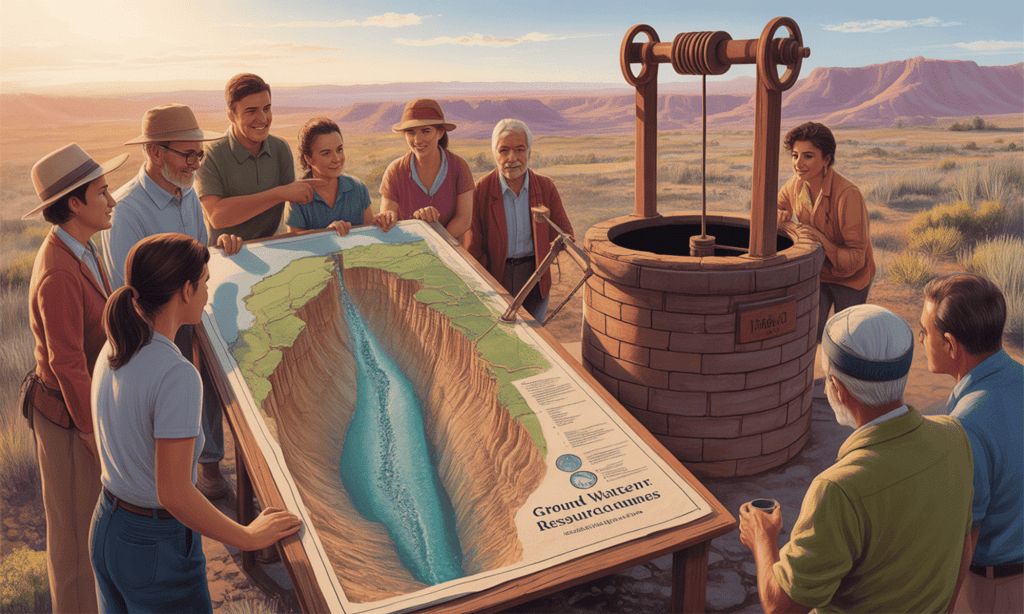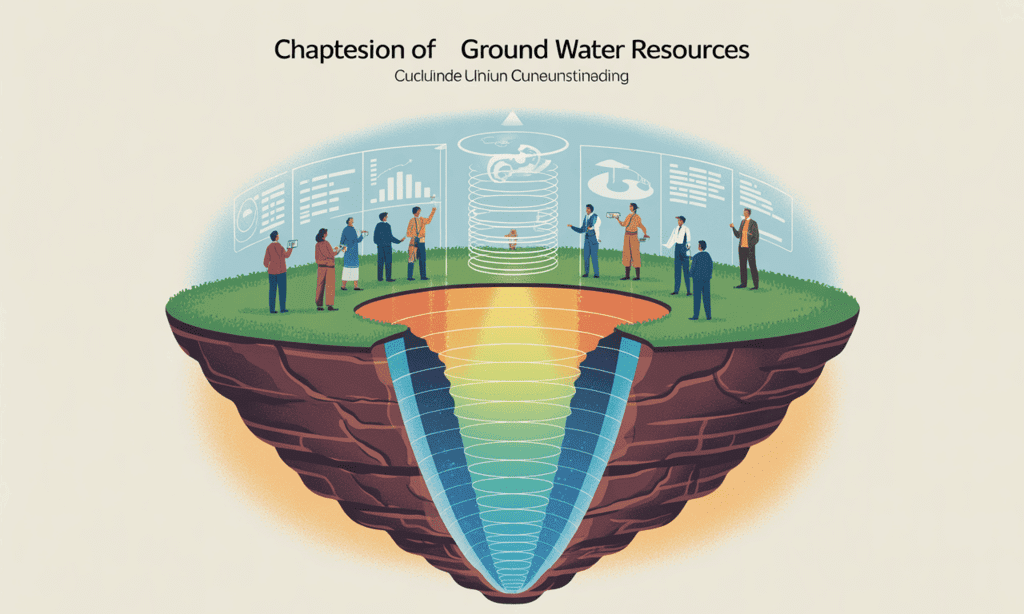Ground Water Resources | Geography Optional for UPSC PDF Download
Overview of Groundwater Use in India
 Groundwater Crisis
Groundwater Crisis
India, home to nearly 18% of the global population, faces significant challenges with groundwater usage. Despite covering only 2.4% of the world’s land area, India consumes 4% of the planet’s water resources. The World Bank has identified India as the largest user of groundwater, a resource crucial for both agriculture and drinking water in rural and urban areas. As the economy and population continue to grow, the pressure on groundwater resources is expected to increase. Experts point out several gaps in groundwater governance in India, which hinder conservation efforts. Reforming groundwater governance and encouraging responsible use can help tackle the decreasing groundwater levels in India.
Current Status of Groundwater Use
- According to the Ministry of Jal Shakti, India has a total annual groundwater recharge of 437.60 Billion Cubic Metres (BCM).
- Groundwater extraction has decreased to 239.16 BCM, the lowest since 2004, with the main uses being irrigation (208.49 BCM), domestic (27.05 BCM), and industrial (3.64 BCM).
- The Central Groundwater Board estimates that 17% of groundwater blocks are overexploited, with critical conditions in regions like North-western, Western, and Southern peninsular India.
- Despite these challenges, there has been a 3% reduction in overexploited units and a 4% increase in safe units compared to 2017.
- India accounts for 25% of global groundwater extraction, with 70% of agricultural water supply coming from groundwater.
Challenges Associated with Groundwater Use in India
- Rising Population: The growing population increases water demand, especially in urban areas where groundwater is a primary source. Indian cities depend on groundwater for about 48% of their water supply.
- Unplanned Urbanisation: Expansion of urban areas with impervious surfaces reduces groundwater recharge and alters natural landscapes, leading to urban flooding and decreased groundwater quality.
- Agricultural Practices: Increased reliance on tube-well irrigation, particularly in Northwest India, contributes to excessive groundwater extraction, exacerbated by subsidies that encourage unsustainable practices.
- Institutional Management Framework Vacuum: Fragmented oversight by various regulatory bodies, outdated legal provisions, and lack of accountability hinder effective groundwater management. The Indian Easement Act, 1882, governs groundwater rights, favouring landowners and excluding those without land rights.
- Groundwater Pollution: Contamination from industrial sites, waste dumps, and sewage systems introduces heavy metals and micro-pollutants into groundwater. Major pollutants include nitrate, arsenic, and fluoride, affecting water quality and safety.
- Climate Change: Irregular rainfall patterns and prolonged droughts, intensified by climate change, disrupt groundwater recharge processes, leading to declining water tables in various regions.
Steps Taken to Improve Groundwater Use in India
 Groundwater Management
Groundwater Management
- Model Groundwater Bill:The Union Government has introduced Model Groundwater Bills in 1970, 1992, 1996, 2005, 2011, and 2016-17. These Bills aim to establish some level of control, suggesting the creation of State groundwater authorities. They proposed registering existing groundwater structures and implementing a permit system, mainly for new wells with electric pumps. The Model Groundwater (Sustainable Management) Bill, 2017, addresses key issues in the current regulatory system and offers a comprehensive approach. Major highlights include:
Key Highlights:
- Strong environmental perspective: Focus on protecting aquifers.
- Bottom-up institutional structure: Encouraging local involvement.
- Drinking water prioritisation: Ensuring access to water, health, and a clean environment.
- Decentralisation principles: Supporting local governance.
- Local committees: Formed for groundwater management.
- Integration of Union Ministries: The Ministry of Jal Shakti was created by merging the previous Ministries of Water Resources, River Development and Ganga Rejuvenation, along with Drinking Water and Sanitation. This integration enhances water resource management, focusing on both demand and supply.
- Initiatives:
Key Initiatives:
- Atal Bhujal Yojana (ABY): Aims for ‘participatory groundwater management’ and encourages behavioural changes through incentives.
- National Project on Aquifer Management (NAQUIM): Focuses on mapping aquifers to collect reliable data for informed decisions.
- Jal Jeevan Mission: Provides safe drinking water to all rural households.
- India-Groundwater Resource Estimation System (IN-GRES): Conducts annual assessments of groundwater resources, supported by developed software.
- Jal Shakti Abhiyan: Promotes community participation through asset creation, rainwater harvesting in the ‘Catch the Rain’ campaign, and awareness efforts.
Steps to Improve Groundwater Use and Governance in India
- Implement Mihir Shah Committee Recommendations:
- Restructure the Central Water Commission (CWC) and Central Ground Water Board (CGWB) into a National Water Commission (NWC) for better water management.
- Establish eight divisions in the NWC for focused management areas like Irrigation Reform, River Rejuvenation, and Water Security.
- Recognise groundwater as a common-pool resource to prevent over-extraction and promote sustainable practices.
- Focus on Integrated Water Resource Management: Promote coordinated development and management of water, land, and related resources for sustainable use.
- Adopt Water-Sensitive Urban Design: Implement planning strategies that manage groundwater, surface water, and rainwater effectively in urban areas.
- Implement Blue-Green Infrastructure: Utilise green spaces (parks, forests) and blue spaces (rivers, lakes) for rejuvenating water bodies and aquifers.
- Enhance Public Awareness and Participation: Foster trust between water sector institutions and communities to improve groundwater management through active participation.
- Review Agricultural Policies: Align cropping patterns with local agro-ecology and eliminate farm subsidies on electricity to optimise groundwater use.
Conclusion
 Groundwater Management
Groundwater Management
- There has been a slight improvement in the situation of groundwater use in India, according to the latest assessment.
- However, the pressure on groundwater resources is expected to increase due to factors such as rising population, urbanization, and uncertainties related to climate change.
- There is a need for a more proactive approach to groundwater management in India.
- The governance framework for water management needs reform to address the challenges effectively.
- Promoting the sustainable use of groundwater should involve awareness campaigns and community involvement, known as Jan Bhagidari, in decision-making processes.
|
303 videos|635 docs|252 tests
|
FAQs on Ground Water Resources - Geography Optional for UPSC
| 1. What are the primary uses of groundwater in India? |  |
| 2. What challenges does India face regarding groundwater management? |  |
| 3. What steps have been taken by the Indian government to improve groundwater use? |  |
| 4. How can governance of groundwater resources be improved in India? |  |
| 5. What role do community initiatives play in groundwater conservation in India? |  |




















